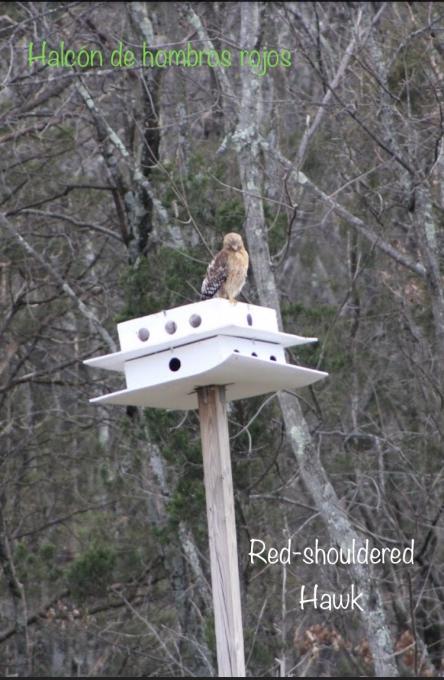Andrea
Forum Replies Created
Viewing 12 posts - 1 through 12 (of 12 total)
-
AndreaParticipantActivity 1: I have taken pictures and notes of local birds, and birds that are in this area for breeding in the Summer. I took some notes during the time when some Mourning Doves made a nest right in front of my window, I took pictures after the eggs hatched and once when the mother was feeding the little chicks. Also, after spending the spring and the first part of the summer listening to Acadian Flycatchers that are temporarily in the local parks I could take a picture of a nest, which was very interesting to see. This has helped me have a more broad view of these species and be more attentive to nests in order no to disturb them.


 in reply to: Activities: Keeping Track of Your Birdwatching #906157
in reply to: Activities: Keeping Track of Your Birdwatching #906157 -
AndreaParticipantActivity 1: I have loved birds for a long time and see the interconnection with them and our ecosystems, but it was very interesting to learn more about their importance in dispersing seeds for many plants and trees to reproduce. Our amazing earth and all that is on it was beautifully and wisely created. Activity 2: I started using less plastic by avoiding plastic bags for kitchen waste. I am doing this by composting in a local program in the area where I live. I use reusable bags for grocery shopping, and I started to buy more in the bulk section, where I bring my containers from home, so I avoid consuming nuts, coffee, and legumes that come in plastic containers. I try to buy mostly organic. I live in a second floor of a building. The first two years living here we would hear a bird colliding with our windows once in a while, so I printed some owls and glued them inside in certain parts of the glass. It has improved the problem significantly. Although it does not look very nice it is an easy solution until I get some window stickers more appropriate to address the issue. Also, although the lesson did not mention... I am more aware of turning off or dimming my lights at night in migration season. Activity 4: I will join a birding group where I live to connect with more birders in my area. I will eBird more so I can contribute with my sights to the community of scientists. I will buy reusable utensils to carry with me when I am outside so I can refuse disposable cutlery if I eat out.in reply to: Activities: Helping Birds in Your World #903665
-
AndreaParticipantActivity 2: Down House: Birds present in towns and buildings such as different kind of pigeons. There are birds that live in open habitats with some woods as farmland such as hawks, kestrels, and woodpeckers. Also there are birds that are present in aquatic habitats as different kinds of gulls. Sevenoaks: Most of the birds are present in aquatic habitats like swamps, marshes, ponds and lakes.in reply to: Activities: Exploring Bird Habitats #903173
-
AndreaParticipantActivity 1: Dora Kelley Nature Park in Alexandria, VA: I can identify at least two habitats where different kind of birds live, a deciduous forest where I identify at least three local species sharing the habitat: Carolina Chickadee, Tufted Titmouse, and White-breasted Nuthatch. Another species that breeds in this area in the summer share this habitat: Acadian Flycatcher. All of them eat insects, but the Acadian Flycatcher catches them in flight. The three local birds eat seed in addition to insects and share the trunks of trees when foraging. In the same park there is another habitat, a river where I usually see at least two species: Mallards, that are omnivore and dabble to feed, and Great Blue Herons, that eat fish and wade slowly or stand still, peering into the water for prey.in reply to: Activities: Exploring Bird Habitats #903158
-
AndreaParticipantActivity 1: I have been observing a Northern Mocking hanging on a power line in front of a house. I think it is the same individual. It sings its long repertoire of songs and calls by itself. While I walk along the street he sings very loud and sometimes it flies in a circle over the wire and returns to the same spot. Activity 2: Mourning Doves and European Starlings were picking the seeds from the ground, Common Grackles elevate their head to forage in the panel that was perpendicular to the ground, Red-bellied Woodpeckers were reaching the food from the trunk-like structure in the feeder. Activity 3: Depending on the time of the day, very early in the morning when it is still dark I hear Mourning Doves and House Sparrows. Later in the day I hear Blue Jays, Northern Cardinals, and House Sparrows, and in the afternoon I hear Gray Catbirds in addition to the ones I have heard earlier during the day.in reply to: Activities: Noticing Behaviors #902759
-
AndreaParticipantActivity 3: Male American Goldfinch (Breeding): The yellow in most of its body is more intense. Intense dark with white patches in the lower part of the wing and in the forehead. The beak is orange. Nonbreeding: Brown/yellowish head with no black parts over the beak; white patches on dark gray on the wings. Common Loon: In Summer colors of the plumage are more intense. Black in the neck with some stripes in the neck that go all along the lower part of the body. Black with white spots in the back. In Winter colors are dull, more grayish. The red in the eyes is the same in Summer and Winter. Activity 4: Birding Spot: Dora Kelley Nature Park: What I expect to find now: Acadian Flycatcher, Red-eyed Vireo, Gray Catbird, Chimney Swift. Eastern Wood-Pewee, Ruby Throated Hummingbird, Great Crested Flycatcher, Blue-Gray Gnatcatcher, Wood Thrush, Blackpoll Warbler. What I expect to find in six months: all year residents such as Northern Cardinal, Red-Shoulder Hawk, Red-bellied Woodpecker, Downy Woodpecker, Pileated Woodpecker, Blue Jay, American Robin, American Crow, Carolina Chickadee, Tufted Titmouse, White-breasted Nuthatch, Carolina Wren, European Starling, House Sparrow, Song Sparrow.in reply to: Activities: Different Seasons, Different Birds #900006
-
AndreaParticipant- Year-round residents (Northern Virginia) Carolina Chickadee/ Tufted Titmouse/ White-breasted Nuthatch: the three of them share the same habitat. Both, the White-breasted Nuthatch and the Carolina Chickadee are smaller, but they have specific behaviors. Although they also share the same colors in their plumage their shape is distinct. Their calls are also very particular for each one of them. I hear them and see them all the time, even in the winter they are abundant. - Residents for part of the year: Gray Catbird/ Yellow Warbler/ Wood Thrush: Ii saw the Wood Thrush for the first time last year in the Summer. While birding I was intrigued by this flute-like call that sounded as if it was actually calling me. I waited and followed it until I saw it, a very pleasant finding. I noticed a Gray Catbird last year in the Summer too, then searched information about it and saw it with my binoculars when chirping the cat-like call. Then this year starting in Spring I have seen many of them flying around and with the help of the Merlin ID I have learned more types of its calls, very diverse and lively. The Yellow Warbler I saw it for the first time three weeks ago and was a very pleasant view of a yellow little thing flying close to a river. Then I searched more information about it.
 Wood Thrush in reply to: Activities: Different Seasons, Different Birds #898108
Wood Thrush in reply to: Activities: Different Seasons, Different Birds #898108 -
AndreaParticipantActivity 1: - The Northern Cardinal is abundant in Northeast of US all year round. The Blackburnian Warbler is abundant in this region and Canada in breeding season (June-August). During the pre-breeding season the last one is spread in East US, Central America and along the Andes Range in Colombia, Ecuador, and Peru. In Non-breeding season (December-beginning of March) it is abundant in Costa Rica, mountains of Colombia, Venezuela, Ecuador, and Peru. (In Northern Virginia, where I live is abundant in May and June) - The Scarlet Tanager is abundant in the Eastern US in breeding season and in winter flies to Central and South America. (In Northern Virginia we can look for it in May and June). The Western Tanager is abundant in Western US; between July and November it spreads and flies South to Western Mexico and Central America up to Costa Rica. - The Ruby Throated Hummingbird is abundant in Central America between October and March; in April starts migrating North to Eastern US and Canada. The Rufous Hummingbird is plentiful in Western Canada and Northwest US in breeding season; in June starts migrating South. Between October and March most of them will stay in Mexico. - Sandhill Crane: in breeding season spreads in all Canada and Alaska; in August migrates to Central America and Florida. Yellow-bellied Flycatcher: Between May and August spreads in Eastern Canada, then flies South and stays in Central America during the winter.in reply to: Activities: Different Seasons, Different Birds #896627
-
AndreaParticipantActivity 1: I spent 50 minutes in Long Branch Nature Park; I was able to see a Red-bellied Woodpecker, I heard several others that I was not able to see, but thanks to the Merlin Bird ID app with its Sound ID feature I have been able to learn to identify some of the calls of local birds- I heard some American Crows, Fish Crows, a White-breasted Nuthatch, Carolina Chickadees, Northern Cardinals, a Tufted Titmouse, a Hairy Woodpecker, and a Barrel Owl. Activity 2: From my balcony I have been able to see many Blue Jays, Mourning Doves, Northern Cardinals (they are usually in pairs, if I see a male I look for the female which is usually around in the same tree), and House Sparrows. Activity 3: Next time I go birding I will look for a Northern Flicker which is a very pretty bird and appear in charts as present in this area the whole year. I have heard its calls many times but I haven't been able to see it.in reply to: Activities: Local Bird Exploration #844474
-
AndreaParticipant
 Mourning Dove feeding babies, Summer 2021 in reply to: Activities: Bird ID Practice #841146
Mourning Dove feeding babies, Summer 2021 in reply to: Activities: Bird ID Practice #841146 -
AndreaParticipantActivity 1: MOURNING DOVE: Round body, small head, long slender tail. Medium size bird with small bill. BLUE JAY: Although the size is similar to the Mourning Dove its head is medium size in relation with its body which is more slender. It has a perky crest and long tail. Longer legs than the Mourning Dove. Activity 2: MOURNING DOVE: Plain brown overall with dark spots on wings. Darker brown on wings and lighter brown in head and breast. Under the wings and tail it looks a little beige. WOOD THRUSH: Uniform brown above from head to tail. White on face, under the bill and breast. Darker brown spots from cheek down, concentrated and clearly defined on upper breast, becoming smudgier towards belly. NORTHERN MOCKING BIRD: Gray/Light brownish on head, on top of the wings, and tail. Whitish underparts. On top wings are darker with white patches on wings and tail. Activity 3: WHITE-BREASTED NUTHATCH: Forages up - down and sideways over tree trunks and around large branches. It starts often high in trees and move down head first. Chips away at wood to find food. Eats insects and seeds. Stores them under loose bark in trees in its territory. In winter joins chickadees, titmice, and woodpeckers to forage. GREAT BLUE HERON: Usually forages alone. It stands still into shallow water or open fields stalking fish and other prey. When they see prey in the water introduce their bill fast to catch them. MOURNING DOVE: It scatters seeds on the ground and in the open. It pushes aside ground litter, but doesn't scratch at the ground. Swallows seeds and stores them in an enlargement of the esophagus called the crop. Once they've filled it they fly to a safe perch to digest the meal. Activity 4: RED-SHOULDERED HAWK: Medium size in the raptors group. Medium size head and balanced with the size of the body. The tail is rounded, medium size. Very short neck almost unnoticeable. Very short bill with hook shape. The little feathers around the eye extend to the back creating a soft border pointing to the back. They fan out the tail when they soar, and the tips of the wings point forward a little bit. Light brown / reddish in the breast with soft white brush strokes on the underparts. In the back the feathers are black with brown border in the upper side and half down are white in the border. The tail is black with white bands and the lower border is white. Flying under the wings you can see in the interior side a "V" shape of brown color with dark dots. the exterior part under the wing is white with dark bands that go all the way to the end of the tail. On top the wings are dark brown with white bands. Brown eyes. brown head with white brush strokes. BEHAVIOR: it soars over forests. It can be seen perched on tree branches or wires. Hunts small mammals, amphibians, and reptiles. HABITAT AND RANGE: Lives in deciduous forests and swamps or suburban areas mixed with woodlands. It builds nests in a main crotch of large trees. Medium distance migrant. The ones that live North East and Northern Midwest migrate to more southerly states for the winter. Some in the East spend winter in Mexico but in the West Coast they are non-migratory. SOUNDS: Call: high pitch whistle. Loud "kee-aah" of different lengths. SOUNDS: Call: high pitch whistle. Loud "kee-aah" of different lengths.in reply to: Activities: Bird ID Practice #841143
-
AndreaParticipantActivity 1: SECRETARY BIRD: It was interesting to learn that its name comes from its elaborate crest that recalls secretaries. It is far from sedentary; it is very active hunting by kicking its prey with its powerful legs and toes. PROTHONOTARY WARBLER: Beautiful yellow feathers. Fiercely defensive of their territories. Both sexes are aggressive in their interaction with the same sex. Pair bonds that usually last the season and continue through the winter. Activity 2: SONGBIRDS: Gray Catbird: Lives in open woodlands and eats insects. It copies the sounds of other species and some of its calls are similar to cats and frogs sounds. PIGEONS AND DOVES: Mourning Dove: Lives in open woodlands and eats seeds. It nests in trees and perches in telephone wires. RAPTORS: Red-shouldered Hawk: Lives in forests, eats mammals, and nests in trees. It returns to the same nesting territory year after year. Activity 3: My favorite bird is the Red-shouldered Hawk: it is common in the area where I live. I see them by themselves, in foggy winter days perched in trees, which makes a beautiful scene. They are very elegant and I love their delicate plumage in their breast like little brush strokes.
 in reply to: Activities: Exploring Birds #837542
in reply to: Activities: Exploring Birds #837542
Viewing 12 posts - 1 through 12 (of 12 total)
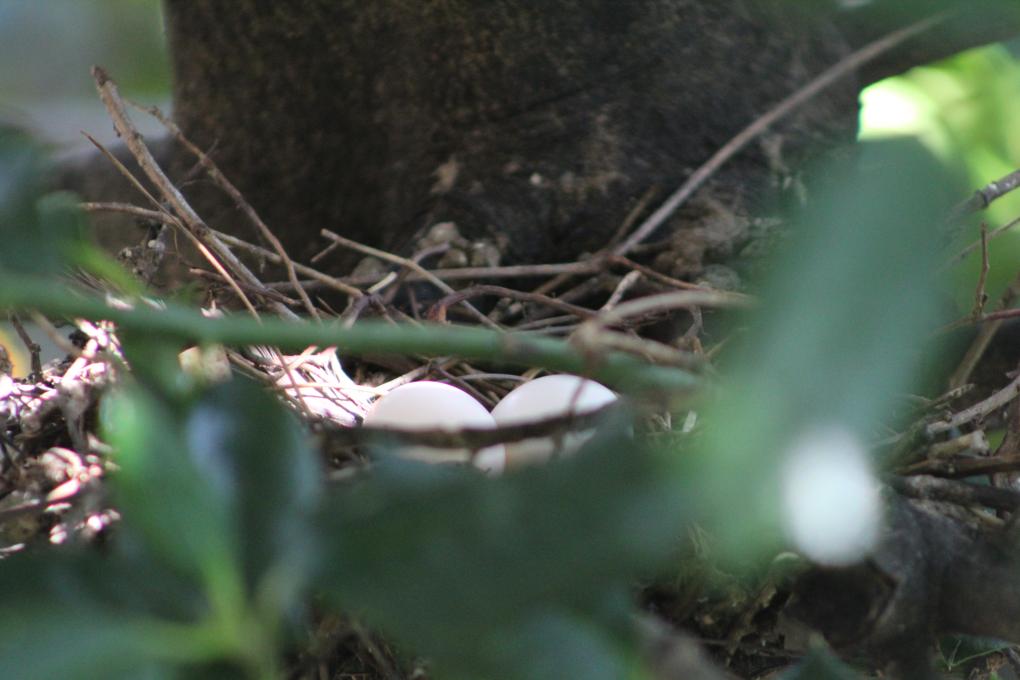
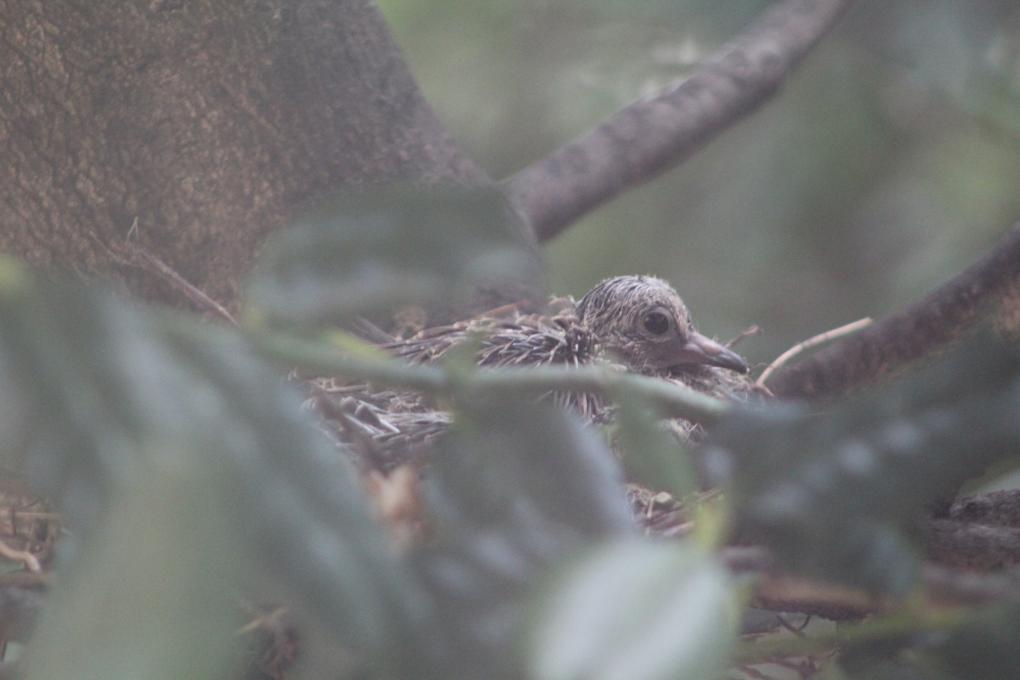

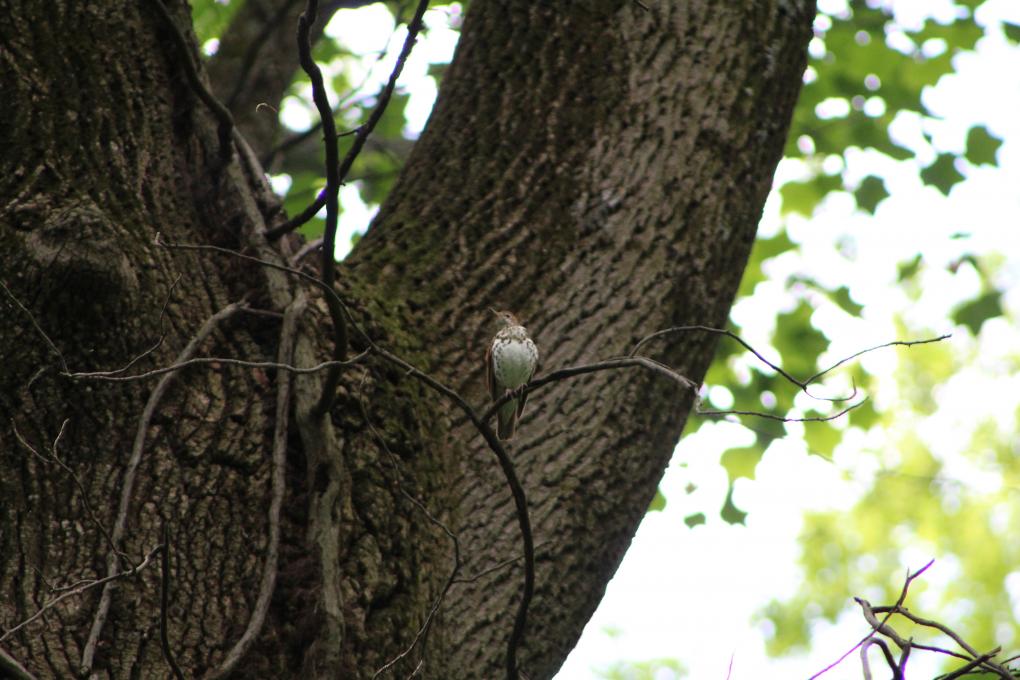 Wood Thrush
Wood Thrush 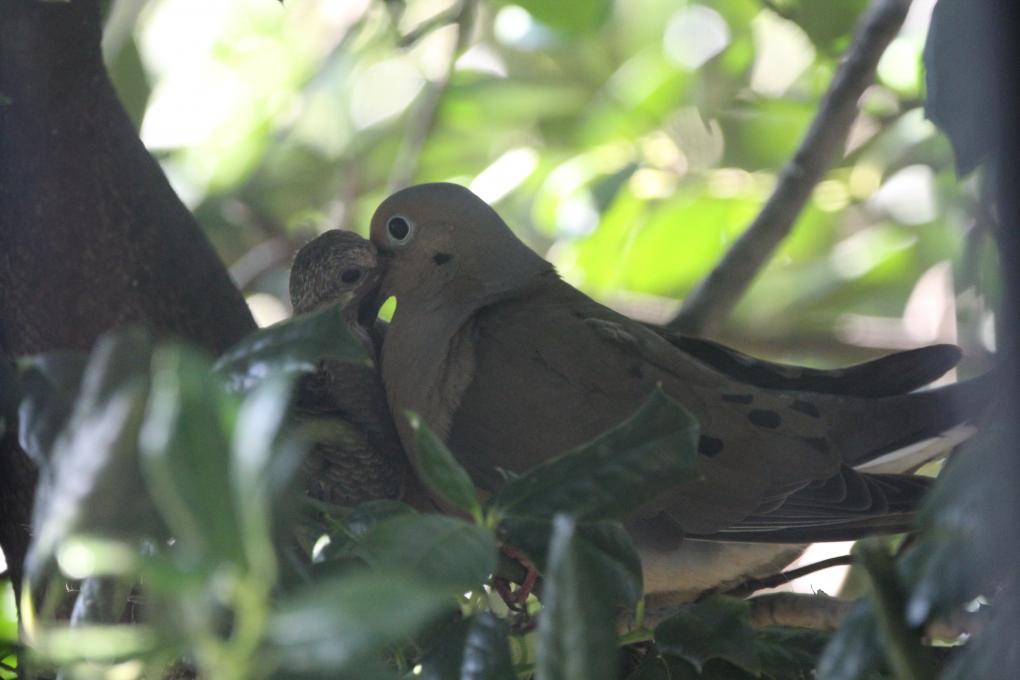 Mourning Dove feeding babies, Summer 2021
Mourning Dove feeding babies, Summer 2021 